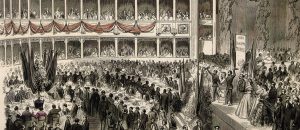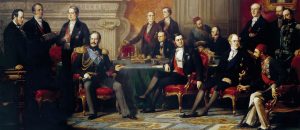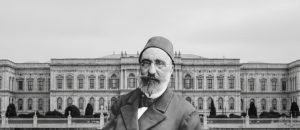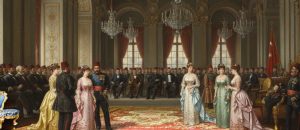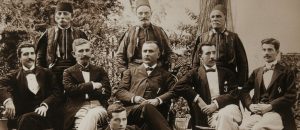The world-renowned Hereke carpets, which turn the floors of Dolmabahçe Palace into art galleries, are the most magnificent proof that Westernization was not merely about importing luxury goods from Europe, but also about the ambition to create a domestic and national luxury industry brand. The Hereke Imperial Factory was established as a “palace workshop” specifically to meet the furnishing needs of Dolmabahçe Palace, but over time, with its quality and original designs, it gained international fame and became one of the Ottoman Empire’s first global brands. Every knot of a Hereke carpet reflects both the artistic soul and the industrialization vision of an empire. [Link: Dolmahçe Palace Collections -> /explore/palace-collections]
Why a New Carpet? Why Hereke?
Until the 19th century, Ottoman palaces were furnished with classical Turkish carpets woven in the traditional carpet centers of Western Anatolia, such as Uşak and Gördes. However, [Link: Dolmahçe’s European-style architecture and furniture -> /tahtlar-koltuklar-ve-konsollar-dolmabahcenin-mobilyalari-guc-ve-konforu-nasil-yeniden-tanimladi] caused these traditional carpets to be incompatible with the new spaces in terms of scale and pattern. The palace’s enormous halls required carpets of much larger dimensions, with a finer and more “courtly” aesthetic that was in harmony with the patterns of the furniture (Baroque, Rococo). Importing carpets from Europe was both very expensive and undesirable for the empire’s prestige. In response to this need, by order of Sultan Abdülmecid, a weaving factory was established in Hereke, near Izmit, in 1843, to produce exclusively for the palace.
The Hereke Imperial Factory: An Art and Industry Workshop
The Hereke Factory was designed more as a modern industrial facility than a traditional carpet workshop.
- Central Design: The patterns were specially drawn by artists and designers employed at the court (foremost among them the French designer Monsieur Chenavard), in accordance with the palace’s architectural style and the decoration of the rooms. This was a radical departure from traditional, improvisation-based folk carpet weaving. Each carpet was part of a holistic decoration project.
- The Best Materials: The highest quality Bursa silk and Anatolian wool were used in the carpets. The colors were obtained with natural root dyes that were resistant to fading and yielded vibrant, rich tones.
- Superior Technique: The double knot technique known as the “Turkish knot” (Gördes knot) was used. This technique ensures that the carpet is denser, more durable, and its patterns are clearer. The number of knots per square centimeter in Hereke carpets was far greater than that of any other carpets produced at the time, which gave them incredible fineness and richness of detail.
- Enormous Sizes: Hereke had the capacity to produce carpets in previously unwoven sizes, such as the massive 124-square-meter carpet produced for the Muayede Hall (Ceremonial Hall) of Dolmabahçe.
The Carpets of Dolmabahçe: Designs Reflecting the Spirit of the Space
The Hereke carpets in Dolmabahçe Palace are not just floor coverings but works of art that reflect the spirit and function of the room they are in.
- Muayede Salonu (Ceremonial Hall): Befitting the splendor of the hall, a huge carpet was designed with medallions and rich floral patterns, dominated by red and cream tones.
- Süfera Salonu (Ambassadors’ Hall): In this hall where diplomatic meetings were held, there is a carpet with Neoclassical patterns, reflecting a more serious and formal atmosphere.
- Harem Apartments: In the rooms of the Harem, more elegant, floral-patterned (especially tulips, carnations), pastel-toned, and smaller-sized carpets were used.
These carpets are one of the most important parts of the [Link: palace’s “total work of art” (Gesamtkunstwerk) concept -> /butuncul-sanat-eseri-dolmabahcede-mimari-ve-susleme-neden-ayrilamaz]. Complete harmony was observed among the ceiling decoration, wall color, furniture style, and carpet pattern.
The Birth of an Imperial Brand
Initially producing only for the palace, Hereke gradually became known in Europe for its quality. Its fame spread with the awards it won at international fairs (Paris 1855, Vienna 1873). European royal families and aristocrats began to order carpets from Hereke for their own palaces. Thus, Hereke, born as a palace workshop, became one of the Ottoman Empire’s first luxury export brands. This is a significant success story showing that Westernization was not just an import process, but could also trigger original and high-quality production with the right strategies.
Conclusion
In conclusion, the Hereke carpets that adorn Dolmabahçe Palace are like “an empire laid on the floor”; each pattern tells of the Ottoman aesthetic taste, and each knot tells of the desire for industrialization and the vision of creating a national brand. This factory, born from the needs of the palace, took traditional carpet art to a new level by combining it with court aesthetics and created a symbol of prestige recognized internationally. Hereke carpets cover not only the floors of Dolmabahçe but also the empire’s self-confidence in the fields of industry and art.









